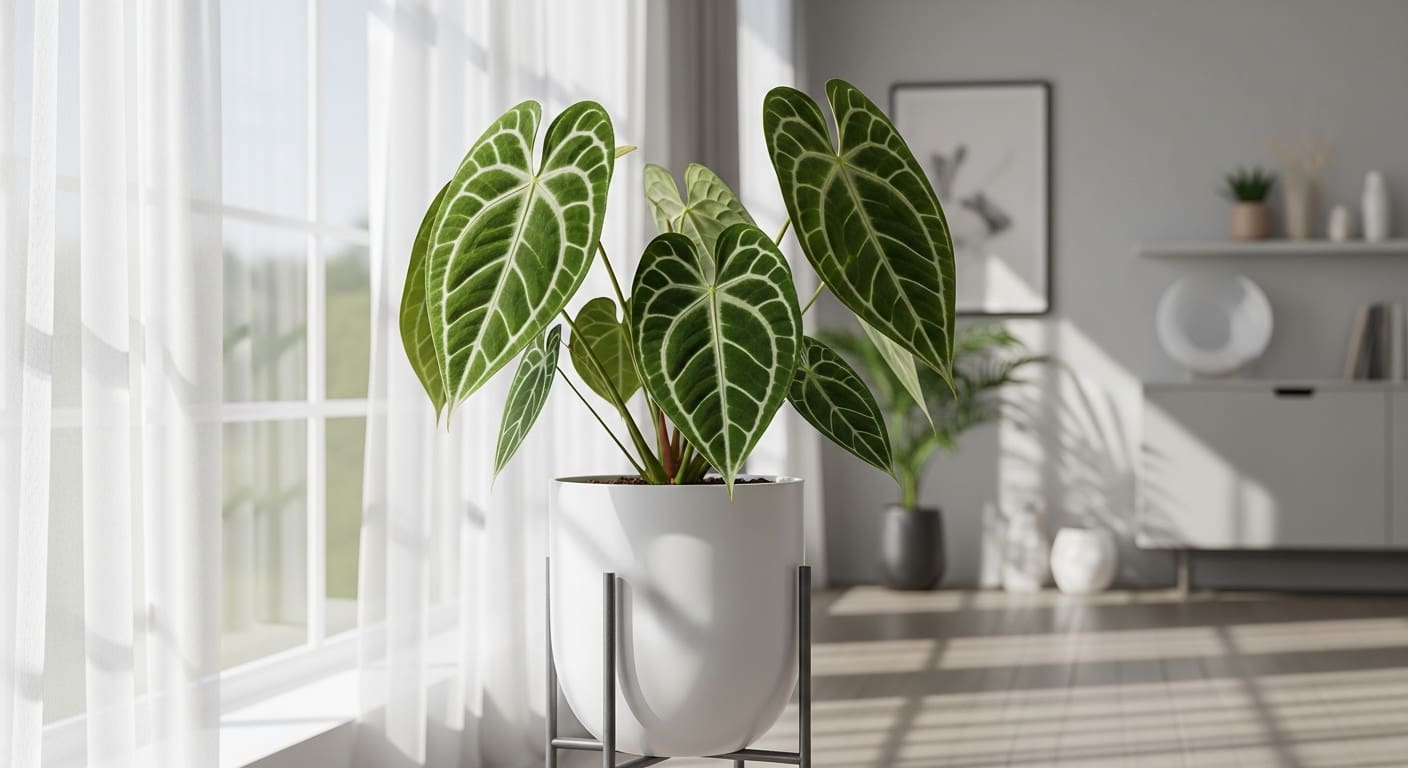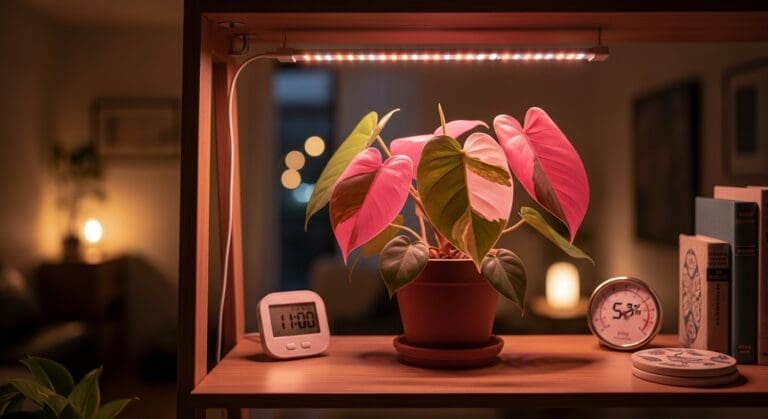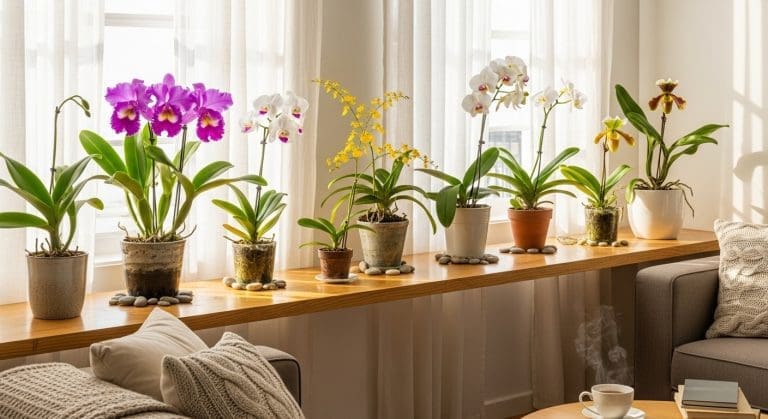Few foliage plants spark as much “wow” as Anthurium clarinervium—those velvety, heart-shaped leaves veined like a chalk drawing. It’s not hard, but it is particular. The shortcut to success? Treat it like a numbers game: light by lux, moisture by rhythm, and mix by ratio—with just enough airflow to keep those velvet leaves pristine.
| Window & Shade | Distance | Midday LUX | Action |
|---|---|---|---|
| East, light sheer | 40–60 cm | 3,000–5,000 | Ideal daily range |
| West, light sheer | 60–80 cm | 4,000–6,000 | Watch heat peaks |
| South, sheer | 80–120 cm | 5,000–7,000 | Diffuse & increase RH |
| North, no sheer | 20–40 cm | 2,000–3,500 | Ok; add LED in winter |
| Grow light (1000 lm) | 25–35 cm | ~3,000–4,500 | Use diffuser |
“On the days I keep it simple—steady light, airy mix, patient watering—my clarinervium repays me with a new leaf that looks stitched by hand.” If you love measurable steps, this guide is your home base.
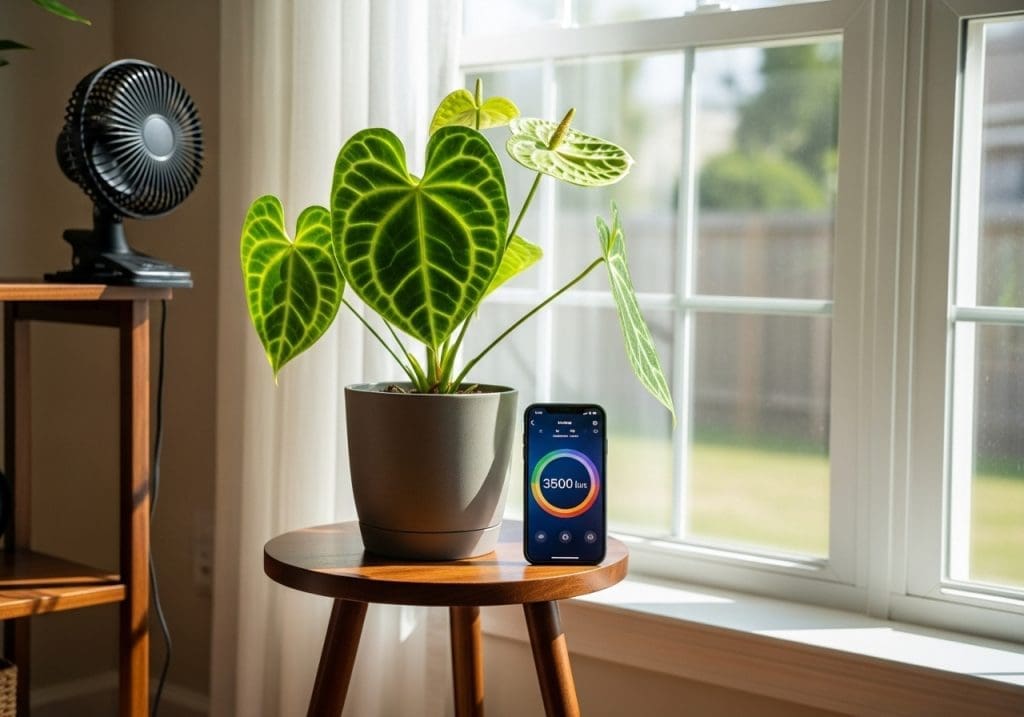
Quick specs (by the numbers)
- Light (lux at leaf height): 2,000–6,000 lux all day; short peaks to 8,000 are fine if humidity is steady and light is diffused.
- PPFD (optional): ~50–150 µmol/m²/s for growth, not “sun-tank” speeds.
- Temperature: 18–26 °C (warmer = faster growth; keep nights a little cooler).
- Humidity: 60–70% RH steady, with gentle airflow 24/7.
- Watering rhythm: moisten evenly, then wait until top 3–4 cm is dry; usually every 7–10 days in active growth, 10–14+ in cooler months.
- Fertilizer: 3-1-2 or similar at ¼–½ strength every 2–4 weeks spring–early autumn; flush monthly to avoid salt build-up.
- pH (substrate): 5.5–6.5 slightly acidic.
“Aim for consistency: bright, filtered light, an airy mix, and never-soggy roots,” notes an RHS houseplant advisor—principles that fit clarinervium perfectly. For a clear refresher on humidity and watering basics, see the RHS houseplant care page.
Light: set it by lux, not by guess
Bright, diffused is the sweet spot. Think east window with sheer or bright north; at a south/west window, add sheer or move 0.5–1.0 m back. Keep daily readings around 2–6k lux at leaf level. If you use LEDs, raise the fixture or add a diffuser to avoid hard hotspots on velvet lamina.
“Is my phone light meter good enough?” Yes—calibrate your eyes with numbers, then trust the plant. If you want a quick lux primer (and phone-meter tips), skim Bright Indirect Light for Ferns: A Practical Lux & Foot-Candle Guide; it translates perfectly to velvet aroids.
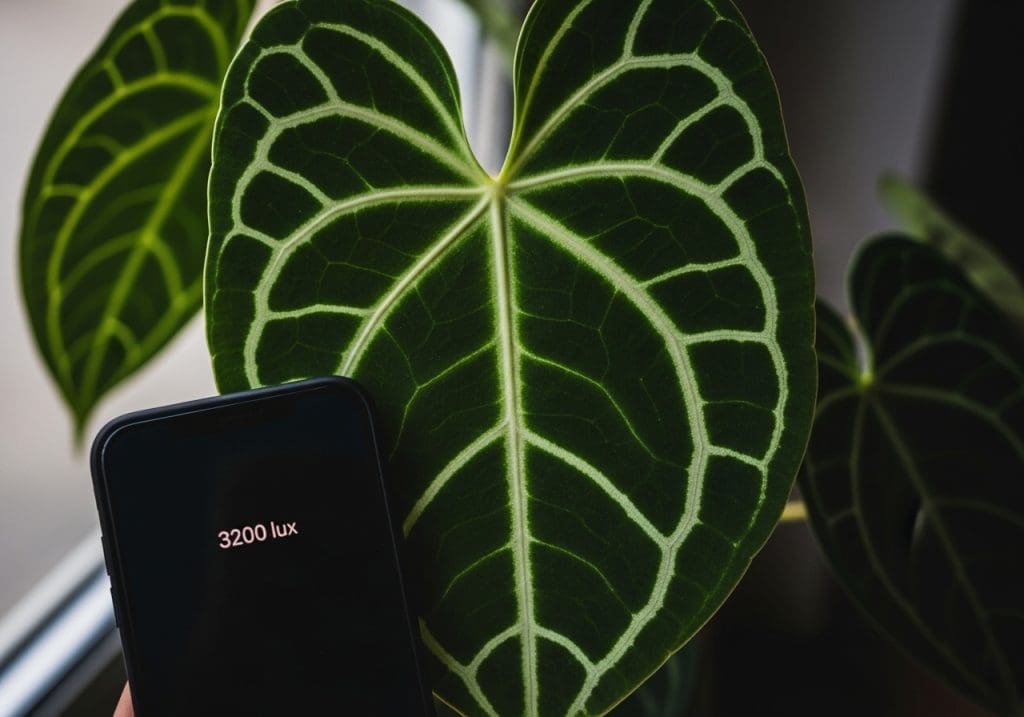
Mix: airy, moisture-holding, and slightly acidic
Clarinervium roots like oxygen first, moisture second. A reliable by-volume recipe:
- 40% medium orchid bark (chunky structure)
- 20% perlite or pumice (drainage/air)
- 20% peat-free houseplant compost or coco coir (water retention)
- 10% long-fiber sphagnum (capillary moisture)
- 10% horticultural charcoal (keeps the mix sweet)
Optional top-dress of milled sphagnum keeps the crown cushioned and slows surface drying. Choose breathable plastic with side-slots or a ceramic pot with big drainage holes. If your space runs very dry, swap 5–10% bark for more sphagnum in winter.
pH 5.5–6.5 keeps nutrients available without encouraging salt burn. If you fertilize regularly, give the pot a clear-water flush every 4–6 weeks.
| Component | Base | Dry Climate | Humid Climate |
|---|---|---|---|
| Orchid bark (med.) | 40% | 35% | 45% |
| Perlite/Pumice | 20% | 25% | 20% |
| Compost/Coco | 20% | 20% | 20% |
| Long-fiber sphagnum | 10% | 15% | 8% |
| Charcoal | 10% | 5% | 7% |
Target pH: 5.5–6.5; flush with clear water every 4–6 weeks.
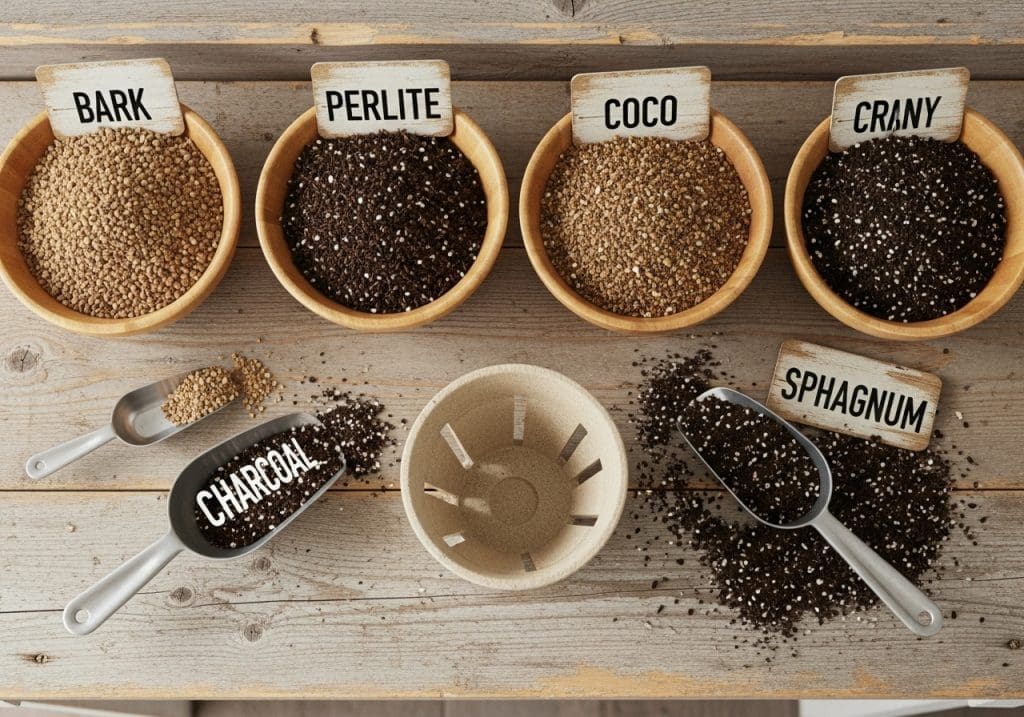
Watering: even soak, complete drain, patient wait
Velvet Anthuriums hate yo-yo moisture. Water slowly until you get 10–20% leachate from the bottom, then let the top 3–4 cm dry before the next soak. In living rooms this equals 7–10 days in spring–summer; in cooler months, 10–14+. Lift the pot to “learn” its dry weight—light pot = time to water.
Brown edges or yellow splotches? That’s often overwatering or salt build-up, not thirst. Flush monthly and never leave the pot sitting in a saucer of water.
Fungus gnats love damp, organic mixes. If they crash your party, this calm step-by-step plan works without nuking roots: Fungus Gnats in Ferns—Control Methods That Actually Work.
Humidity & airflow: keep it moist, not muggy
Clarinervium looks best at 60–70% RH with airflow. A quiet clip-fan skimming past leaves prevents fungal spotting and keeps the boundary layer thin (that still air hugging a leaf). Put your hygrometer at leaf height—wall readings lie.
If you’re building a dedicated corner, gear sanity-check and placement tips here: Quiet Humidifiers & Hygrometers for Bedroom Plant Lovers.
RHS’s general advice to prioritize even warmth, filtered light, and measured watering dovetails nicely with this plant. When in doubt, re-read the RHS houseplant care fundamentals and keep your routine steady rather than extreme.
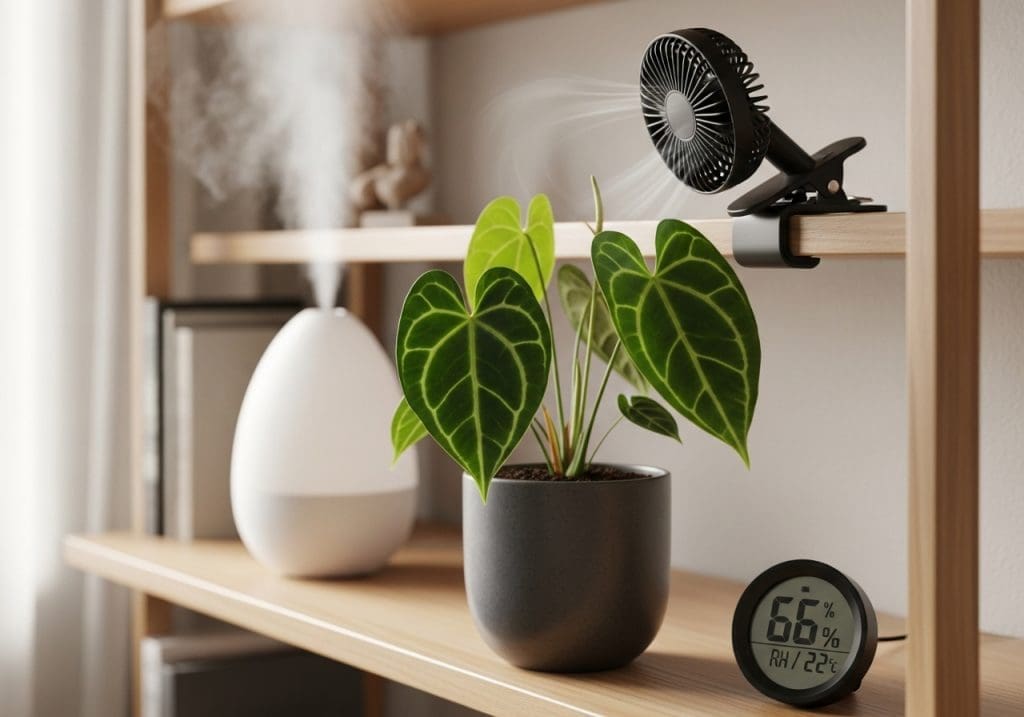
Feeding: little and often
Use a balanced 3-1-2 (or similar) at ¼–½ strength every 2–4 weeks in active growth. In low light or cool rooms, cut frequency in half. If you track EC, stay around 1.2–1.8 mS/cm in leachate; otherwise, rely on the monthly flush to keep roots happy.
Leaf edges crisping while tips stay green? Often too much light + low RH. Pull light back (or add sheer) and raise RH a notch.
Repotting & roots
Repot every 12–18 months or when roots circle the pot. Don’t jump more than one pot size; extra mix stays soggy. When you unpot, healthy aroid roots look firm, creamy-tan, not mushy. Trim dead roots back to firm tissue.
If your plant sulks after repotting, check three levers: light within range, airflow constant, watering slower, deeper (don’t “sip water” it back to health).
Propagation: division beats cuttings
Clarinervium branches at the crown; the cleanest method is to divide when you see multiple growth points:
- Unpot and tease roots gently apart; use sterile snips only if needed.
- Make sure each division has at least one growth point and a good root bundle.
- Pot into slightly smaller containers than you think you need; keep humidity steady and airflow gentle for 2–3 weeks while roots re-establish.
(Stem cuttings can work on some Anthuriums, but clarinervium is far more reliable via division.)
Troubleshooting by symptom (quick cues)
- Yellow patches + limp feel: overwatering or compacted mix → increase bark/perlite, lengthen the dry-down.
- Brown, crispy margins: too much light + low RH → diffuse light, raise RH to ~65%, keep fan on.
- Dull, dusty leaf surface: rinse gently in the sink; velvet traps dust.
- Slow growth despite good light: room too cool or roots cramped → lift temperature a notch and consider a small up-pot.
“Is this rare species worth the investment if my room runs dry?” If your RH hovers at 35–40% all winter, budget for a quiet humidifier and a small fan before you budget for the plant. The gear pays for itself in clean, long-lived leaves.
Seasonal routine (simple & realistic)
- Spring–Summer: hold 3–5k lux most of the day; water every 7–10 days; feed biweekly; flush monthly; check for thrips/mites during heat spikes.
- Autumn: reduce feed to monthly; watch lower sun angles—sheer may need adjusting; keep airflow as days cool.
- Winter: maintain 2–4k lux with sheers open and LEDs higher; water every 10–14+ days; keep RH 60–70% but never stagnant.
For leaf-by-leaf light confidence, keep that phone meter handy and revisit the lux guide whenever conditions change.
A note on origins (and why “aroid logic” helps)
Clarinervium hails from limestone regions of southern Mexico; in nature it grows terrestrially or epilithically (on rock), often in bright shade with moving air. That explains our recipe: air spaces, steady moisture, filtered light. If you like the botany backdrop, Kew’s resources on aroids are a great rabbit hole for context and classification; start browsing via Kew – Plants of the World Online and look up Anthurium to explore relatives.
“Every new leaf reminds me to trust the boring habits—measure light, water slow, keep air moving. It’s surprisingly un-fancy, and it works.”
Change log: Aug 2025 – Added LUX × distance table; mix variants; propagation HowTo schema; expanded symptom matrix.
Anthurium Clarinervium Indoor Care
Anthurium clarinervium is a striking foliage plant known for its heart-shaped leaves and prominent white veins. According to Kew’s Plants of the World Online, this species originates from southern Mexico, where it grows in limestone-rich forests.
Light Requirements
This plant thrives in bright, indirect light. A north or east-facing window is often ideal. You can also measure light intensity with a Lux Meter App to ensure the plant receives at least 500–1000 lux consistently. For further guidance, see RHS Houseplant Care.
Humidity & Airflow
Anthurium clarinervium prefers high humidity (60–80%). According to EPA Indoor Humidity Guidelines, keeping indoor humidity between 30–60% is healthy for both people and plants, so a humidifier may be needed for this species. Ensure gentle airflow to prevent fungal issues.
Soil & Watering
Use a chunky, well-draining mix containing orchid bark, perlite, and peat moss. Water when the top 2–3 cm of soil feels dry, ensuring the pot has proper drainage to avoid root rot.
Fertilizing
Feed every 4–6 weeks during spring and summer with a balanced liquid fertilizer, ideally with a 3-1-2 NPK ratio. UNH Extension explains how NPK ratios support healthy leaf growth while avoiding excess salts that damage roots.
Sources
- Kew – Plants of the World Online
- Royal Horticultural Society – Houseplant Care
- Lux Light Meter App
- EPA – Indoor Humidity Guidelines
- UNH Extension – Fertilizers

RarePlantCare Editorial Team produces expert content on rare plants.
Our articles are AI-assisted and human-edited before publication.
We aim to provide practical, evidence-based guides for plant lovers worldwide.
Learn more about our Editorial Policy


